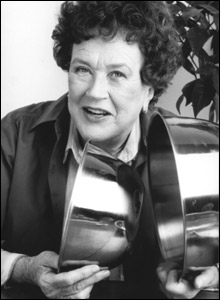A long-time writer reflects on our city’s culinary history
By ROBERT NADEAU | November 15, 2006
Food and cultural historian Laura Shapiro likes to point out a certain week in 1963 when Julia Child first appeared on WGBH and Betty Friedan published The Feminine Mystique. The dates couldn’t have been much further apart in 1966 when Joyce Chen started her cooking show on WGBH, and a Boston University theater student published the first issues of what became the Boston Phoenix. In 1966, Boston wasn’t known as a particularly good restaurant town, outside of a few expensive places like Locke-Ober, Café Budapest, and the Ritz-Carlton dining room. The last two are gone, and Locke-Ober hangs on only because, after it excluded women from its main dining room for more than a century, it was rescued by Boston’s most famous female chef, Lydia Shire. In 1966, moreover, home cooking began and usually ended with Fannie Farmer, although some new ideas from Child and Chen were coming in via public television.
WONDER WOMAN: Julia Child appeared on WGBH in 1963. The rest is history.
|
But under the radar flew a whole different kind of restaurant and home cooking, appealing to a new generation of students and young professionals. The restaurants were inexpensive, ethnic, and bohemian. Such rooms, often mere storefronts with a dozen tables or fewer, were discussed in the pages of the Phoenix and its predecessors, and first joined our community of advertisers. Alt-weekly readers and writers might splurge at Maison Robert, the city’s finest French restaurant and a Julia Child favorite. But we frequented cheap Italian restaurants in the North End and such outposts of red-sauce value as Simeone’s in Cambridge. In an adventurous spirit, we might join the cult of computer hackers gathered over Peking ravioli at Joyce Chen’s Small Eating Place. A few people even ventured to Medford’s Peking on the Mystic for more of this new, spicy, and more-authentic Chinese food. Other gathering places included the handful of Greek and Lebanese restaurants downtown, in the South End, and Cambridge, like the old Athens Olympia and the original Red Fez. After midnight, you could get breakfast all night at a colorful spot in the central meat market called Mondo’s. (Mondo’s clientele of night-owl students, taxi drivers, artists, and prostitutes has never been reassembled, but its collection of amateur nude oil paintings was a precursor to the Museum of Bad Art.) Bars and luncheonettes with cheap comfort food were popular, such as the old Brookline Lunch in Central Square, which became a lefty political hangout, and the pre-punk Model Café in Allston. The English Tea Room at 29 Newbury Street had a certain flare, as did a hippy/Mexican restaurant in Harvard Square called El Diablo, and — upstairs from a Cambridge fish market — a barebones spot with paper plates and blackboard specials called Legal Sea Foods.For a treat, Boston Phoenix readers sought out competing homemade-ice-cream parlors in Somerville. Boston has been an ice-cream region since the early-19th century, but the last 40 years have taken ice-cream mania to new levels. (This is one way Phoenix readers have always had fun with food: tasting something at the absolute top level of a basically inexpensive category. We may not wear $5000 watches, but we indulge in a high-end ice-cream cone after a modest meal, a super-premium bottle of beer with our burger, a superb silk scarf to accessorize our thrift-shop clothes.)
 Related
Related:
Child's play, Tajine, 25 Classes That Will Get You $50K, More 
- Child's play
Here's something I never thought I'd write: Nora Ephron has made one of the best movies of the year.
- Tajine
With visions of spices of the souk, we are apt to imagine that Moroccan food is as spicy as that of Mexico or Ethiopia.
- 25 Classes That Will Get You $50K
Unless you dream of becoming, say, a Franciscan monk, a retail clerk, or a freelance writer, vows of poverty probably don’t show up on your career checklist.
- 2009: The year in movies
As I looked over my list of the best movies of 2009, it suddenly struck me: where are all the women on screen?
- A haute time
My introduction to the concept that a bottle of wine must breathe did not go well. I was already in a state from drinking nonvintage stuff when I arrived at the small dinner party. Then, the hostess announced she would let the bottle breathe and placed it before me on the table. I could imagine little strangled gasps coming from the bottle.
- A compendium of regional recipes and tasty tales
May your head dance with visions of sugarplums.
- J Hogue
Dr. Seuss, David Bowie, Mike Watt, Zuzana Licko, and Julia Child. That’d be quite a night.
- House of Chang
For more than 30 years, this location housed Lucky Garden, one of the first neighborhood Mandarin-Szechuan restaurants in Greater Boston, and one of the best in stretches.
- The big cheese
Is cheese the new breakthrough trend?
- Galway House
Getting tired of reading about $40 steaks, $60 steaks, $120 Japanese Wagyu beef steaks?
- Petit Robert Bistro
This is Petit Robert Bistro #2, or II, or deux. Or, since this space, formerly Rouge, is smaller than the original Petit Robert, maybe it’s Plus Petit Robert.
- Less

 Topics
Topics:
Food Features
, Michael Dukakis, Lydia Shire, Julia Child, More  , Michael Dukakis, Lydia Shire, Julia Child, Chris Schlesinger, Betty Friedan, Laura Brennan, Maison Robert, Mary Chung, Joyce Chen, Laura Shapiro, Less
, Michael Dukakis, Lydia Shire, Julia Child, Chris Schlesinger, Betty Friedan, Laura Brennan, Maison Robert, Mary Chung, Joyce Chen, Laura Shapiro, Less 